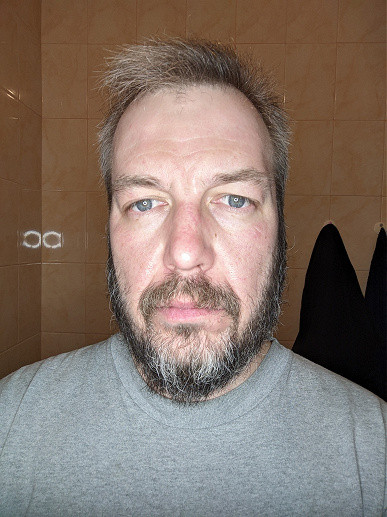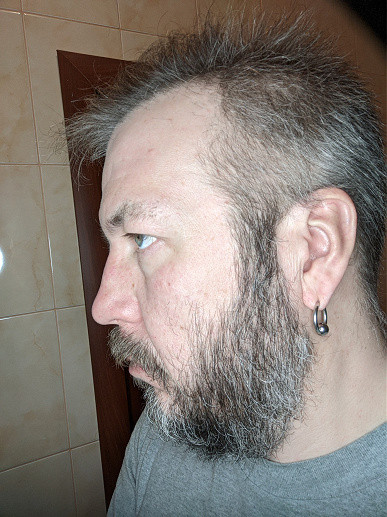The new Polaris electric razor that came to us for testing is called PMF 1015RC wet&dry 7D Prof 3+. As the name suggests, razors have long since surpassed 3D shaving, quietly moved through 4D and 6D, and now, ta-dam! welcome! — innovative 7D system for adapting to facial contours!
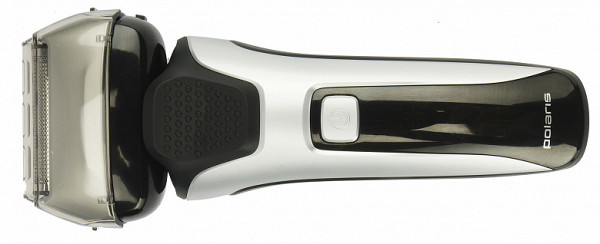
Without going into marketing gimmicks, this is a regular foil razor with three shaving units and IPx6 water protection rating. This means that it is suitable for both dry and wet shaving. Let's test it in action right away.
Characteristics
| Manufacturer | Polaris |
|---|---|
| Model | PMF 1015RC wet&dry 7D Prof 3+ |
| Type | foil shaver |
| Country of Origin | China |
| Guarantee | 3 years (battery — also 3 years, blades and mesh — 3 months) |
| Life time * | 3 years |
| Number and type of knives | 3 pieces |
| Floating head | Yes |
| Floating knives | No |
| Trimmer | There is |
| Battery | Li-ion, 800 mAh |
| Indicators | connecting the power adapter, charge level |
| Waterproof | yes, IPX6 |
| Battery operation | up to 90 minutes |
| Battery charge time | 90 minutes |
| Powered by power adapter | Yes |
| Accessories | charger, carrying case, cleaning brush |
| Availability of spare knives/heads | in the Polaris brand store |
| Blade/head life | announced the need for replacement every 2 years |
| Weight | 205 g |
| Dimensions (W×H×D) | 50×167×70 mm |
| Network cable length | 1.2 m |
* Contrary to popular belief, this is not the time limit after which the device will necessarily break down. However, after this period, the manufacturer ceases to bear any responsibility for its performance and has the right to refuse to repair it, even for a fee.
Equipment
The razor is packaged in a compact cardboard box-box, decorated in the Polaris corporate style: black background, high-quality printing, on the front side there is a photo of the device, on the sides there is a description of the main features and characteristics.
The box has a hinged lid. Under it there is a plastic holder, which contains the razor in a case. Additional accessories are hidden in the space under the tray.

Having opened the box, we found inside:
- the razor itself in a protective case
- charger and charging cable
- cleaning brush
- user manual, warranty card, promotional materials
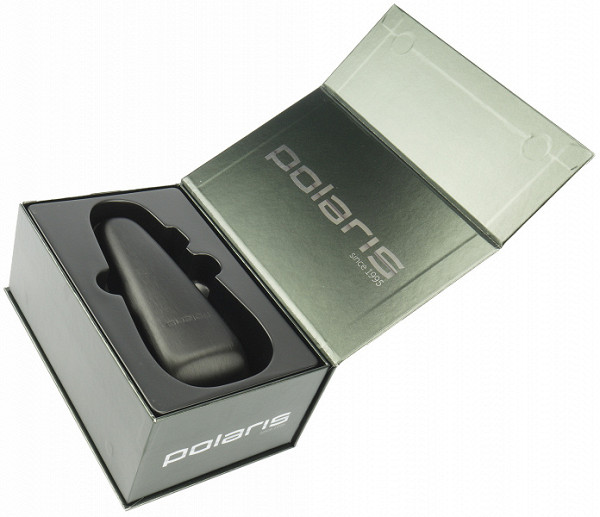
At first sight
The razor looks strict and stylish, leaving the impression of a more expensive device compared to other Polaris models.
The body is made of several types of plastic: the back panel is matte black, the front part is a plastic insert painted silver-gray. On the front there is also a grip zone with characteristic bumps and glossy translucent plastic, under which a simple display is hidden.
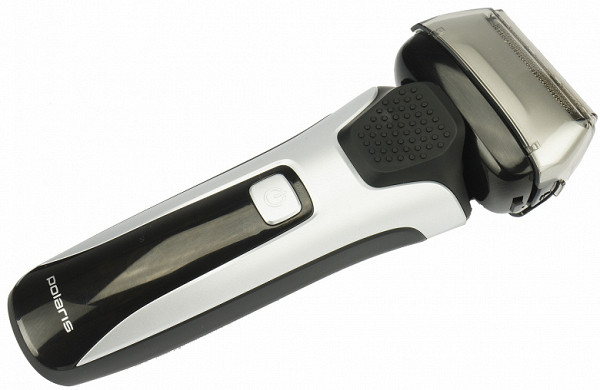
The shape of the device is classic: on top there is a head with a removable cutting block (the width of the knives is 35 mm).

The block is removed and installed using two side snap buttons located on the sides of the head. The cutting unit itself can only be installed in one position; it cannot be turned over. However, there are no marks indicating correct installation. Pay attention to the small tab on the front side to avoid getting confused.
Removing the knife block, we see two knives mounted on plastic spring-loaded bases. In the center there is a trimmer for longer hairs, which works synchronously with one of the knives, transmitting the movement from the motor unit.

Thus, we counted three cutting elements.
Having examined the shaving head, we found two shaving foils on the edges and a trimmer grid in the center. This design is reminiscent of solutions from Braun. It is important to note that all shaving elements work independently of each other and are not fixed relative to each other. Each foil and trimmer functions as a separate razor: when pressed, they can «sink» into the blade block on one side or both, to the same or different depths.
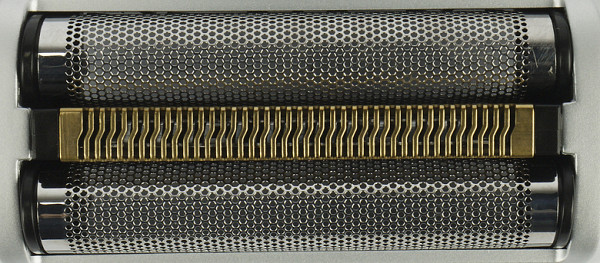
We have come across systems where shaving foils “pull” the following cutting elements along with them, creating a “ladder” of three elements when one of the foils is fully pressed. This is not the case here.
The shaving head can tilt left and right a few degrees, but there is no forward or backward tilt.
To protect the knife block from damage, a plastic cover is included in the kit.
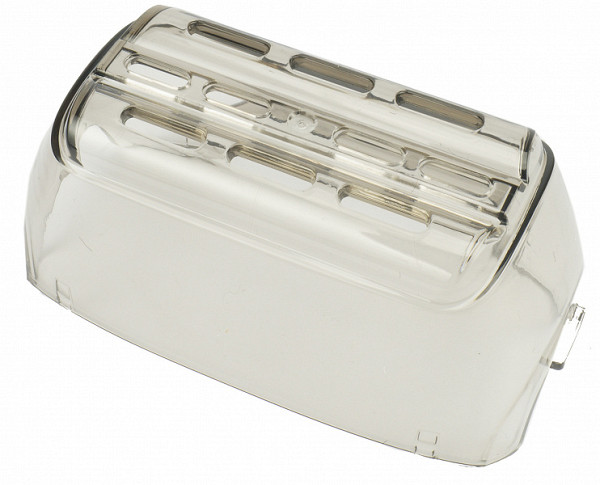
The front has a special grip zone made of soft plastic with pimples, which feels tactile almost like rubber. It is pleasant to the touch and comfortable to hold.
From the back, your finger hits the trimmer cover or its opening button.
The trimmer on this razor extends and retracts manually. To do this, you need to press the locking button and move it forward or backward relative to the device body.

The dimensions of the trimmer are small: the width of the cutting part is 2.5 cm.
On the back side there is also information about the razor — model number and technical specifications.
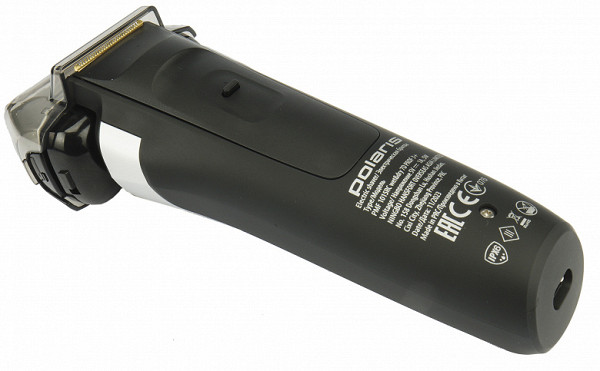
On the front, below the grip area, there is a power button, below is an LED display, and below it is the Polaris logo. The display is hidden behind darkened glass and is not visible when the shaver is turned off.
At the bottom of the razor there is a charging connector. The length of the wire is 1.2 meters, which is quite enough to charge the device. However, if the shaver is being used on mains power, the cord could be longer so that the socket is closer to the sink or mirror. The kit includes a standard charger with an output of 5 V 1 A.
It's worth noting that the charging connector has a unique form factor rather than the popular USB standard, so finding a replacement charging cord if it gets damaged or lost can be difficult.
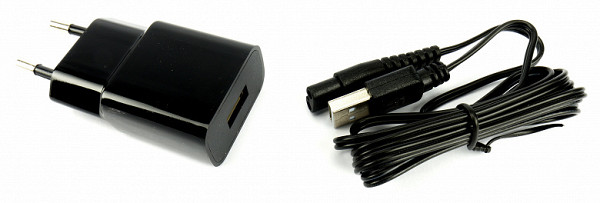
The storage case (and travel case) is made of a tough material covered in faux leather and closes with a zipper. It looks much more stylish than many other “travel bags”, although it does not give the feeling of increased reliability.
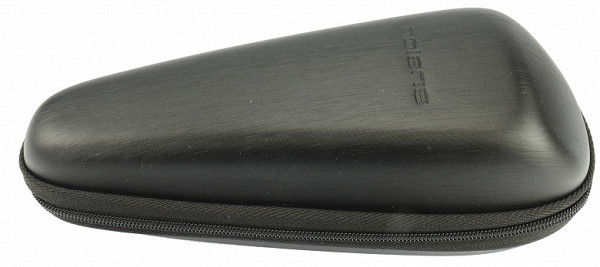
There is not much free space in the case, so you won’t be able to fit the charger and power cord here.
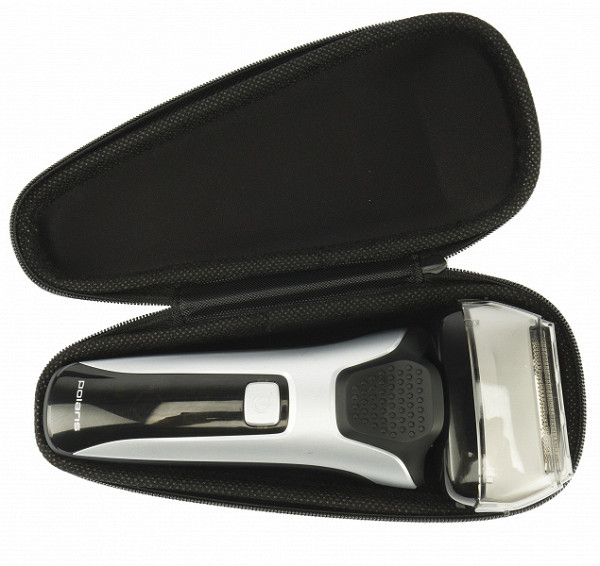
Also included in the kit is a standard brush for cleaning the blades.

Instructions
The instruction manual is a compact brochure printed on high-quality glossy paper. Russian and Kazakh languages are represented.

After studying the instructions, you can familiarize yourself with the description of the device, obtain information regarding the rules of operation, care, storage and disposal of the device.

In general, everything is simple and clear. All actions are provided with clear and detailed illustrations; the text component also does not raise any questions.
Control
The device turns on and off using a single mechanical button. During operation (and charging), the display shows the battery charge level.
In addition, the display contains an indicator of the operation of the knives, an indicator of blocking from accidental activation, as well as an indicator of the need to clean the shaving module.
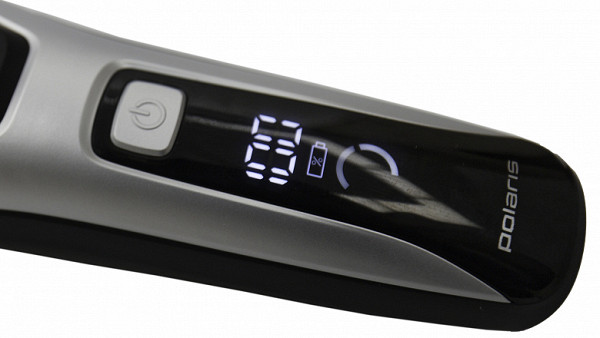
The lock is turned on and off by long (3 seconds) pressing the power button.
Exploitation
Before first use, it is recommended to fully charge the device, which may take about one hour. In our case, the razor was 95% charged out of the box.
The device can operate in two power consumption modes: from the built-in battery or from the mains with a connected power cord. In plug-in mode, the razor will work if the built-in battery charge level is at least 1%.
The shaving rules are standard: the razor head should be positioned at an angle of 90° to the surface of the skin and moved back and forth against the growth of the stubble. For dry shaving, it is recommended to use cream or lotion after the procedure to prevent irritation.
Wet shaving involves using shaving foam or gel to hydrate the skin and reduce friction. The wet shaving method is only permissible in stand-alone mode.
Shaving the neck is done in a similar way, pressing the razor to the desired areas of the face and making smooth movements.
Using the trimmer is not difficult: we pull it out and trim the hair in the direction of its growth.
The razor can work continuously for up to 90 minutes. However, it is recommended to take breaks at least every 10 minutes. The blade unit does not get very hot, but the trimmer can get quite hot.
During operation of the device, we did not find any particular difficulties or problems. Everything was clear and predictable.
Care
The razor requires regular cleaning, which is recommended weekly. Shaving heads should be cleaned after every 30 uses.
For maintenance, you need to clean the shaving head with a brush. To do this, remove the head, remove any cut hair, and brush the hair off the blade. If the head is very dirty, it can be washed under running water. Then remove any remaining moisture with a dry cloth, dry the razor thoroughly and put on the protective cover.
Do not completely immerse the razor in water.
Our measurements
When testing a cordless razor, we typically measure the operating time on a full charge and the time it takes to fully charge the battery.
To measure the battery capacity, we carry out several cycles of turning on the device at intervals of 5 minutes. Our razor worked for 18 full 5-minute intervals, turning off almost immediately after the 19th turn on. Thus, without recharging, she was able to work for 90 minutes — exactly as stated.
Fully charging the battery using the included adapter took the same 90 minutes. This is in accordance with the manufacturer's instructions.
Practice tests
During testing, we evaluated the effectiveness of the razor at different stubble lengths and tested the functionality of the trimmer. As usual, we started testing with unshaven hair to get more clear results.
Shaping contours (trimmer)
We decided to try out the snap-on trimmer for contouring and trimming long hair like sideburns, mustaches or beards. Having started by removing excess hair, we soon discovered that the trimmer was not able to process a large volume of hair in one pass. You have to work in small sections, which causes some uncomfortable tugging of the hair. However, the trimmer successfully handles individual hairs, and the overall contours are acceptable.
It took about 4-5 minutes to treat both sides of the face. Overall, the experience of using the trimmer was not particularly satisfying, and although it did the job, using a more suitable device seems to be preferable.
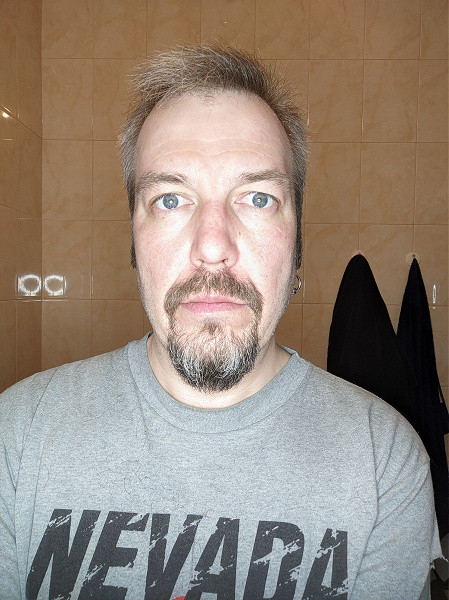
After treatment with a trimmer, the length of the hair turns out to be comparable to two to three days of stubble, and therefore can be easily shaved as usual.

We cannot help but note that the razor itself heats up quite a bit during operation, but the trimmer heats up quite a bit. We wouldn't recommend using it for more than 4-5 minutes at a time.
Result: average
Dry shaving
After continuing to test the razor, we moved on to dry shaving.
Armed with a stopwatch, we began shaving, moving the razor against the direction of hair growth, trying not to rush, but also not to linger too long in one area.
After an unsatisfactory experience with a trimmer, dry shaving turned out to be surprisingly comfortable. We spent about a minute shaving one cheek, and the result was more than acceptable.
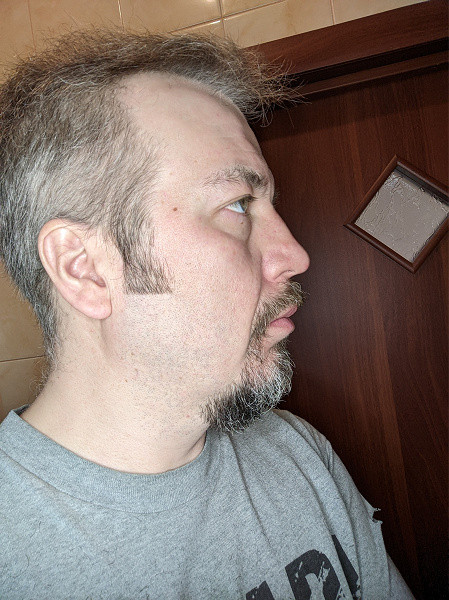
The cheek shave was clean after the first pass. Only some areas required a second pass. On the neck, as usual, the quality of the shave was slightly lower due to the different directions of hair growth. However, there were no overtly long trims after shaving was completed.
Overall, we enjoyed the process. The shave was easy and quick, with no irritation or discomfort.
Result: excellent
Wet shaving
After trying wet shaving, we applied moisturizing gel to the other cheek and began the process. However, not everything was as expected.
The shaving quality remained good, but the feeling of comfort that we expected was not achieved. On the contrary, the skin was more irritated and the process took a little longer.
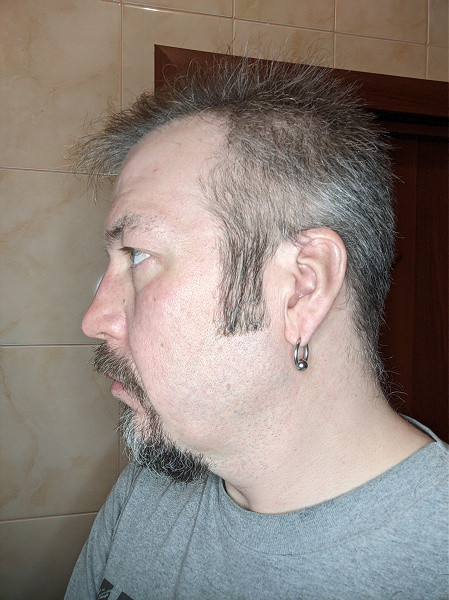
The result turned out to be strange. On the one hand, the shaved cheek seemed to be a little better. On the other hand, we didn’t really like the subjective sensations. We would prefer to shave dry.
Result: good
Chin and neck
The last stage of testing is to check the effectiveness of the razor on the chin and neck areas. We started by removing excess hair with a trimmer and then moved on to dry shaving. And again the result was not long in coming.
Approximately 90% of the hair was shaved off in the first pass, and we identified the remaining 10% by the presence of roughness and trimmed it separately. Overall the process was quick and effortless. In the photo, when zoomed in, you can see the chin area on the right side.

We rate the overall result as excellent on the chin...

...and good in the neck area.
By the way, in the last photo you can see the mark from the trimmer (at the bottom of the neck). Careless movement can lead to such mini-cuts.
Result: excellent
conclusions
From the results of our tests, we drew several conclusions, which turned out to be quite varied. Firstly, the Polaris PMF 1015RC razor showed high efficiency in dry shaving, earning a rating of five points. We have no complaints about this and were completely satisfied with both the quality of the shave and our sensations. In addition, skin irritation was found to be minimal.
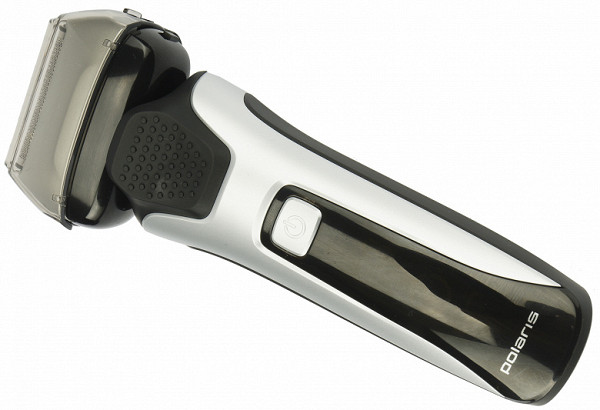
In testing, we found that wet shaving left us with a slightly less positive experience than dry shaving. Although the shaving quality was about the same or slightly better, the skin irritation was slightly more noticeable and the time spent on the process increased.
As for the trimmer, we think its functionality is limited. It's good for removing a few hairs or shaping contours with short stubble, but with long stubble it's slow and not always effective.
However, when it comes to regular use, we are willing to admit that the Polaris PMF 1015RC razor is worth considering. It copes well with dry shaving, providing high quality and minimal skin irritation. Wet shaving is also acceptable, although overall comfort may be slightly lower. The trimmer, although limited in capabilities, should not greatly affect the overall rating of the device.
Pros:
- excellent shaving quality
- fast charging
- stylish appearance
Minuses:
- not the best quality trimmer

